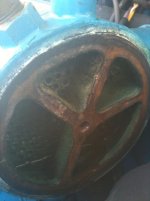makomark
Silver Medal Contributor
This is engineering data from sherwood. represents a modestly used impeller.
If you measure the flow from the pump and then compare it to the flow exiting the u-cooler, you can assess any gross restriction in the u-cooler. There will be a minor pressure drop but i don't think it will have any measurable reduction in the volume delivered.
If you measure the flow from the pump and then compare it to the flow exiting the u-cooler, you can assess any gross restriction in the u-cooler. There will be a minor pressure drop but i don't think it will have any measurable reduction in the volume delivered.


